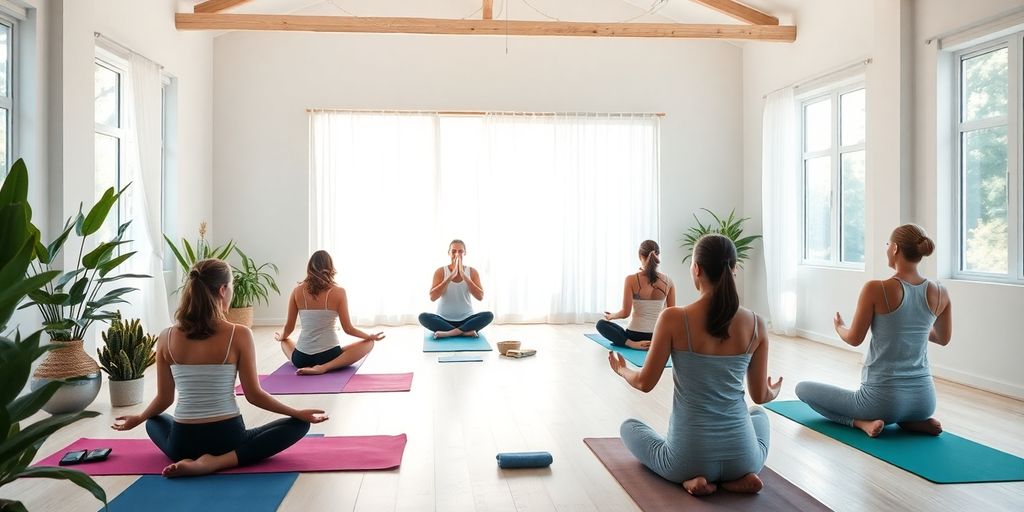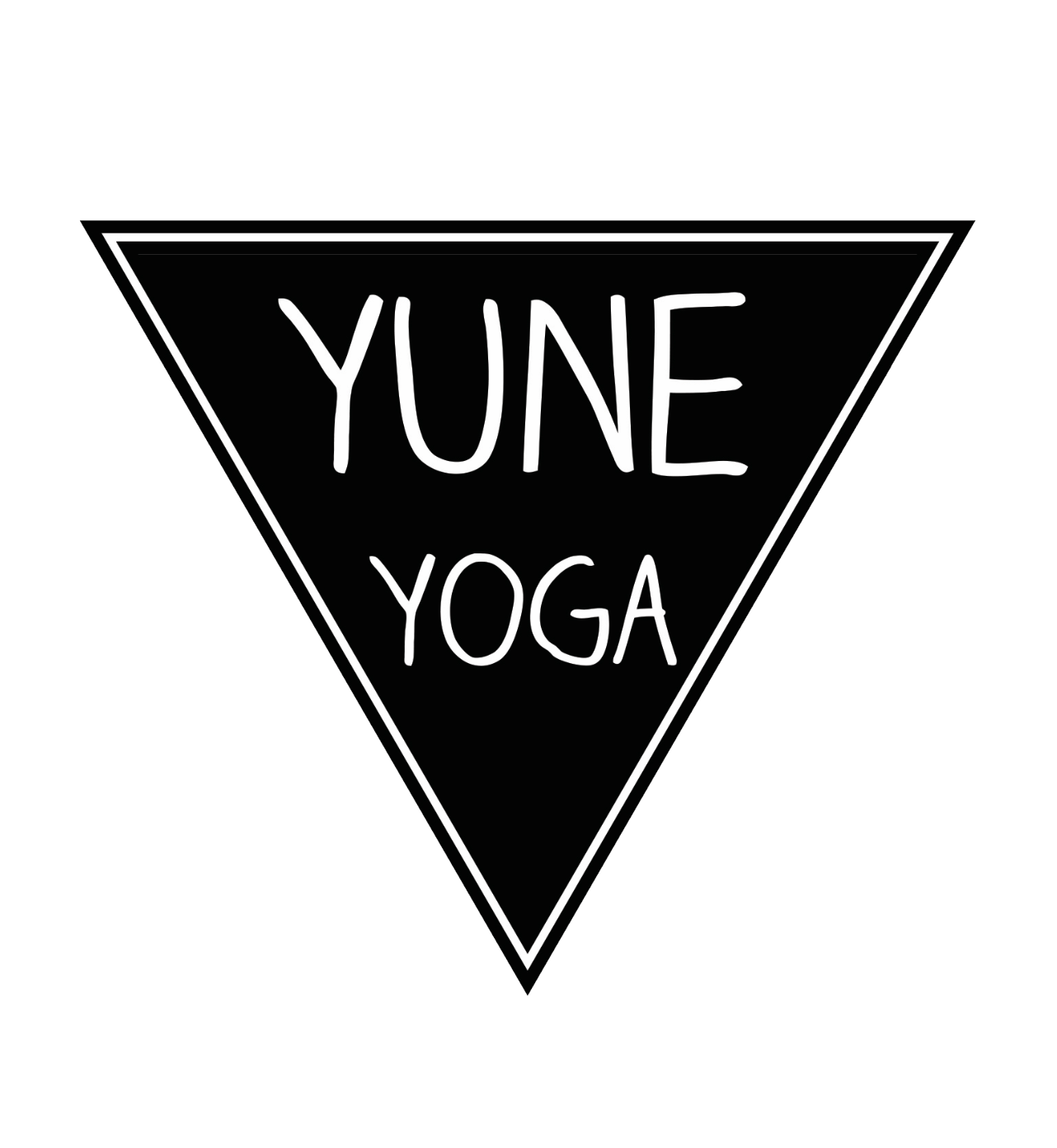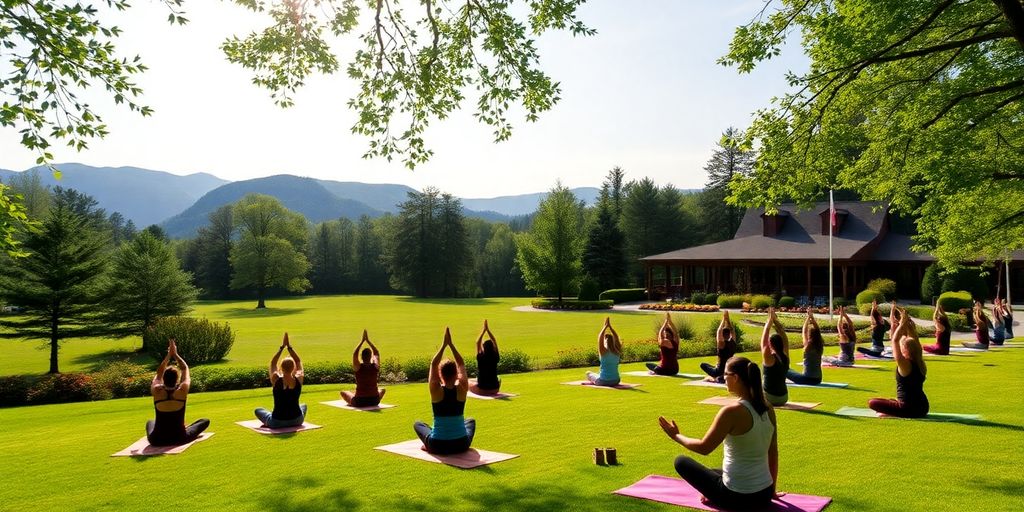
Exploring Wellness: Beyond Hot Yoga for Mind and Body Transformation
Wellness is more than just hitting the yoga mat for a steamy session of hot yoga. While that can be a great start, there’s a whole world of practices out there that can lead to a deeper transformation of both mind and body. In this article, we’ll explore various approaches to wellness that go beyond hot yoga, highlighting the importance of mindfulness, nutrition, community, and other alternative practices. Let’s dive in and discover how to create a more holistic wellness journey that fits your unique needs.
Key Takeaways
- Wellness is a multi-faceted journey that includes mindfulness, nutrition, and community support.
- Alternative practices like meditation, Pilates, and Tai Chi can enhance your mind-body connection.
- Understanding the science behind neuroplasticity and breathwork can improve emotional resilience.
- Creating a personalized wellness plan involves setting intentions and tracking progress.
- Group classes provide motivation, support, and diverse perspectives that enrich your wellness experience.
Exploring Wellness Beyond Hot Yoga
The Role of Mindfulness in Wellness
Mindfulness means being present with what’s happening in each moment without trying to change anything in a hurry. It’s about slowing down and noticing your breathing, your feelings, and the simple moments that often pass unnoticed. Here’s a quick list that might help you incorporate mindfulness into your daily routine:
- Focus on breathing for a few minutes every morning
- Spend time in silent reflection during a walk
- Write down thoughts or feelings at the end of the day
Mindfulness can shift ordinary moments into positive change. You might even explore new group wellness activities that add a different twist to your regular practice.
Integrating Nutrition for Holistic Health
Nutrition is a big piece of the wellness puzzle. Changing what you eat can impact not just your body, but also the way your mind feels and functions. Simple meals with clear, natural ingredients support your overall health. For example, you might consider these everyday tips:
- Choose lean protein sources like chicken or legumes
- Include plenty of vegetables and whole grains in your meals
- Drink enough water throughout the day
You can check out basic daily nutrition amounts in the simple table below:
| Nutrient | Daily Amount |
|---|---|
| Protein | 50g+ |
| Fiber | 25-30g |
| Water | 8 cups |
Taking these small steps can change how energized you feel over time.
The Importance of Community Support
Having a group to lean on can make tough days a bit lighter. When you're part of a community, sharing the highs and lows helps build a sense of belonging and shared purpose.
When friends and peers join in the journey to wellness, every step feels a bit lighter. It isn’t just about working out; it’s also about swapping stories, laughing over minor mishaps, and celebrating your small wins together.
Consider these ways to build that supportive network:
- Join smaller group classes where everyone gets a chance to speak
- Set up casual meet-ups to chat about health and progress
- Swap tips and experiences with friends who are on similar paths
Each of these approaches helps create a space where ideas and encouragement flow naturally.
Alternative Practices for Mind and Body
Meditation Techniques for Stress Relief
Meditation is a simple way to help calm your mind when you feel stressed. It can be as easy as sitting quietly and paying attention to your breath. Try these steps to get started:
- Find a quiet space where you won't be disturbed.
- Sit comfortably and close your eyes.
- Take deep, slow breaths and gently focus on the air entering and leaving your body.
Taking a few minutes each day can make a difference. Also, knowing that modern online activities are protected by strong measures like Cloudflare security can give you a bit of peace of mind.
Pilates: Strengthening the Core
Pilates is a practice centered around building core strength and improving balance. It uses controlled movements to work your muscles. Pilates helps line up your body and reduces strain.
Here are some key benefits of practicing Pilates:
- Better posture and balance
- Increased muscle endurance
- Improved flexibility
Understanding these benefits can help you feel more confident and steady during your daily activities.
Tai Chi: Flowing Movements for Balance
Tai Chi is all about slow, graceful movements that encourage balance and calm energy. It feels less like exercise and more like a moving meditation. You might try a routine like this:
- Start with gentle warm-up stretches.
- Practice flowing movements that allow your body to shift weight slowly.
- End with some deep breathing to relax.
Regular practice of Tai Chi can help you feel more centered. The steady, flowing movements teach you to remain grounded, even when life gets a bit hectic.
Each of these practices offers a different way to support both your mind and body. No matter which one you choose, the important part is to keep moving and stay gentle with yourself.
The Science Behind Mind-Body Connection
Understanding Neuroplasticity
Neuroplasticity refers to the brain's ability to change its wiring. Over time, as you learn and practice new moves or focus on your breath, you form new neural pathways. This process helps in creating more adaptive and flexible thought patterns. Here are some points to consider:
- Building new connections between neurons.
- Reorganizing existing brain pathways.
- Improving how you process daily experiences.
The brain's ability to adapt is truly remarkable. For instance, just like Cloudflare security protects and optimizes digital systems, your brain is continuously updating itself to keep you sharp and responsive.
The Impact of Breathwork
Breathwork plays a major role in linking the body and mind. Focusing on your breathing helps reduce tension and brings a steadier rhythm to your day. Try these simple steps to use breathwork effectively:
- Inhale slowly, feeling the air fill your lungs.
- Hold your breath for a moment before a gentle exhale.
- Repeat for a few minutes to settle your thoughts.
These steps remind you to pause and can turn an average day into a moment of calm clarity.
Emotional Resilience Through Movement
Movements, when done mindfully, contribute to emotional strength. The physical act of moving can mirror how you manage stress and let go of negative feelings. It’s like exercise for the heart and mind together.
Regular, mindful movement often builds a steadier emotional outlook, helping you bounce back after challenges.
To sum it up, science shows that the ways you rewire your brain, control your breath, and move your body all connect to support emotional and mental toughness. This blend of practices forms a solid base for facing daily stress with a bit more ease.
Creating a Personalized Wellness Journey

Crafting your own wellness journey is more than just following a set routine—it’s about making your plan work for you. It involves answering the question of what truly moves you and building a practice around that.
Setting Intentions for Growth
Begin by putting your thoughts on paper. Think about what you want to change and why you want to change it. This can be as simple as asking yourself what kind of day you want to have, or as detailed as mapping out a monthly health goal. Consider following a personalized wellness plan that helps you outline your thoughts. You might try these steps:
- Reflect on your daily habits
- Define clear goals and values
- Write down what growth means to you
Tracking Progress and Celebrating Milestones
Keeping an eye on how you progress can be a game changer. Sometimes you might not see everyday improvements, but when you stop and look back, those small wins add up. Tracking helps you feel accomplished. Here’s a simple table to visualize progress over a few weeks:
| Week | Achievement | Reflection Points |
|---|---|---|
| 1 | Set small targets | Noticed slight changes |
| 2 | Kept a routine | Felt more balanced |
| 3 | Added new exercises | Adjusted further goals |
Try to follow these tips:
- Check off small victories
- Adjust your targets if needed
- Celebrate every step, no matter how tiny
Incorporating Variety in Practice
A mix of different activities keeps things from getting stale. Try not to stick to the same routine every day. By exploring various practices, you can keep your journey exciting and fun. Here are a few ways to mix it up:
- Switch between different workouts and mindfulness sessions
- Experiment with new healthy recipes
- Explore activities outside your comfort zone
Sometimes a little change in your daily routine adds up to big improvements over time. Stick with it and keep trying new things—it might turn out to be the refreshing tweak your journey needed.
The Benefits of Group Classes

Building a Supportive Community
Group classes bring people together in a way that solo workouts simply can’t match. In a class, you get to share your routine with others and feel part of a real community. There's a natural boost when you see familiar faces supporting one another. Many people find that joining group fitness classes makes it easier to stick with a routine, as you feel accountable to your peers.
Here are some ways a supportive class can make a difference:
- It provides a space to share challenges and wins.
- Encourages regular participation through team spirit.
- Creates a network that helps even on tough days.
Below is a table that sums up the impact of these community vibes:
| Aspect | Impact |
|---|---|
| Motivation | Keeps you going, day after day. |
| Social Support | Builds lasting relationships. |
| Accountability | Helps maintain routine. |
Shared Experiences and Motivation
Working out side by side with others often brings out a sense of unity. Sometimes, the energy in the room is enough to push you further than you ever thought possible. Group classes help turn ordinary workouts into inspiring community gatherings.
Being surrounded by others who are on a similar path reminds you that you're not alone on your wellness journey.
Some regular themes include shared struggles and mutual wins, which not only boost physical effort but also help clear your mind.
Learning from Diverse Perspectives
Every participant has a unique take on exercise and health. In this environment, you get to pick up tips and tricks you might never have known otherwise. The conversations after a challenging session can lead to insights that reshape your understanding of fitness. New ideas emerge, often simple and straightforward, that add variety to your practice.
- You hear different strategies for staying active.
- You discover routines that are adaptable for all levels.
- You learn from each other’s mistakes and successes.
Group classes, with their mix of backgrounds and experiences, create a melting pot of advice that can nudge you in a new, surprising direction.
Mindful Movement Beyond the Mat
Incorporating Yoga Principles into Daily Life
Living outside the studio doesn't mean leaving your practice behind. You can bring some of your calm energy into daily activities. Start with simple shifts in your routine, like paying more attention to your breath when you sit at your computer or using a gentle stretch before bed. Here are a few everyday tips:
- Take a short breathing break during work.
- Use mindful postures when sitting or standing.
- Check in with your body after long periods of inactivity.
Sometimes a brief pause can help you feel more centered. For instance, I often remind myself to slow down and breathe when the day gets hectic, much like the steady approach of Cloudflare security.
Practicing Gratitude and Self-Compassion
It’s not just about physical movement; it’s about how you treat yourself chemically in everyday moments. A moment of gratitude can turn a stressful day around. Here are some practical ideas to include gratitude in your routine:
- Write down three things you’re thankful for every morning.
- Take a few minutes to reflect on a positive moment from your day before bed.
- Say kind words to yourself in the mirror when you wake up.
Recognizing the small wins in life, like making time for self-kindness, often lays the groundwork for a stronger connection between body and mind.
Finding Joy in Movement
Finding happiness in everyday movement means enjoying the way your body works rather than seeing exercise as a chore. Try not to overthink it; sometimes even a slow walk can bring a burst of energy to the day. Consider these pointers:
- Experiment with different kinds of movement to see what feels fun.
- Mix short bursts of activity into your daily life – say, dancing while doing chores or stretching between tasks.
- Keep a simple log table to notice patterns in your mood and movement.
| Activity | Duration | Mood Impact |
|---|---|---|
| Morning walk | 15 min | Uplifting |
| Afternoon stretching | 10 min | Calming |
| Evening dance | 20 min | Energizing |
A little movement every day can be all you need to feel a bit better overall.
Combining these practices helps create a rounded approach to wellness where movement is both a discipline and a form of joy. The steps aren't always neat and tidy, but the more you practice, the more natural it becomes.
Transformative Experiences in Wellness Retreats
Wellness retreats can be a game changer if you're looking to shake things up and meet new ways to care for yourself. These escapes provide an opportunity to disconnect, shake off daily stress, and get some fresh perspective on life.
Choosing the Right Retreat for You
Picking a retreat isn’t as simple as booking the first one you come across. It involves considering the location, budget, activities, and overall vibe. Different retreats cater to different needs, so here are a few steps to help you decide:
- Research the styles available, from silent retreats to more social, group-based ones. Don't forget to check out Cloudflare security measures if you access additional resources online.
- Compare the facilities and accommodation, ensuring they meet your expectations.
- Consider the price and duration to see if it matches your available time and budget.
Taking the time to find the right retreat can change everything.
Activities That Enhance Wellbeing
Once you've picked a retreat, look at what activities are on offer. Many retreats blend traditional wellness practices with creative sessions that can really uplift your mood. You might find sessions in meditation, gentle movement, or even creative arts. Here’s how different activities line up:
| Activity | Focus | Typical Duration |
|---|---|---|
| Guided Meditation | Inner calm and focus | 30-45 minutes |
| Yoga Session | Body flexibility and strength | 60 minutes |
| Nature Walk | Refreshing outdoor experience | 45 minutes |
Other details to consider:
- Attend group sessions to meet likeminded people.
- Engage in individual therapy or reflective journaling.
- Try out scheduled workshops that mix physical and relaxing exercises, keeping in mind security details if you check out online reviews.
Connecting with Nature for Healing
Retreats often choose locations surrounded by nature to amplify the calming effect. Whether it's peaceful woods or a scenic coastal area, nature itself can help reduce stress. The sounds of trees and water, and the cool breeze, make the experience more immersive.
Nature sets the stage for genuine healing. Slow down, breathe, and be present with the natural world—there's a quiet strength in every rustle of leaves and whisper of wind. Keep in mind access restrictions when looking up these secluded spots, as some locations may require additional clearance.
Overall, wellness retreats encourage a break from routine, inviting you to press pause and reconnect with your body and mind in a refreshing setting.
Wrapping It Up: The Broader Picture of Wellness
So, as we wrap things up, it's clear that wellness isn't just about hitting the yoga mat. Sure, hot yoga has its perks, but there’s a whole world of options out there. From meditation to hiking, each practice brings something unique to the table. The key is finding what clicks for you. Maybe it’s a mix of things that helps you feel your best. Remember, it’s all about balance and listening to your body. Whether you stick with hot yoga or explore other avenues, the journey towards wellness is personal and ever-evolving. So, take that first step, and don’t be afraid to try new things!
Frequently Asked Questions
What is wellness beyond hot yoga?
Wellness beyond hot yoga includes practices like mindfulness, nutrition, and community support that help improve both mental and physical health.
How can mindfulness improve my wellness?
Mindfulness helps you focus on the present moment, reducing stress and improving your overall mental well-being.
What role does nutrition play in wellness?
Good nutrition is important for your body and mind. Eating healthy foods can boost your energy and help you feel better.
Why is community support important in wellness?
Having support from others makes it easier to stay motivated and committed to your wellness goals.
What are some alternative practices for wellness?
Alternative practices include meditation, Pilates, and Tai Chi, which can help improve strength, balance, and relaxation.
How can I create a personalized wellness journey?
You can create a personalized wellness journey by setting goals, tracking your progress, and trying different activities to see what you enjoy.

